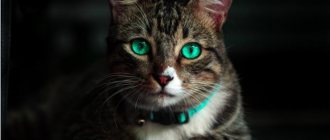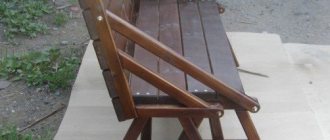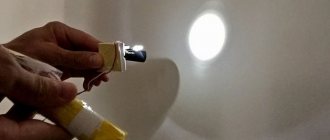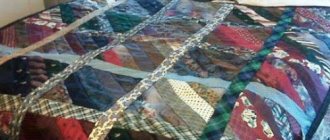How to do it yourself?
Your task is to create a flat reflective surface, looking at which the optical illusion of an infinite mirror will appear. To make it you will need :
Naturally, you can always resort to the ancient methods of our grandmothers and build an open mirror system in which the focus of the viewer's gaze will be parallel to the mirror planes. In this case, the height of the lamp will be equal to the width of the reflective surface, which a priori will not be very convenient.
Our goal is a mirror plane that will not reduce the height of the room. To create it, you need a closed-type optical system, in which a person’s gaze will be directed perpendicular to the mirror surfaces.
One of the mirrors must allow a portion of photon ducts from the light source to pass through; if you do not follow this point, you will not be able to make and see an infinite mirror.
To make your own light well you will need:
Implementation of 3D design
You can build a structure with the optical illusion effect of an “infinity mirror” in different ways, depending on the type, quantity and quality of materials you have. Further in the article you will learn one of the simplest ways to create a light tunnel.
Materials
▍Glass (mirror)
I used the Pilkington Mirrorpane. It turned out to be the most expensive part of the project (200 Canadian dollars). While reading various materials on the topic of smart mirrors, I learned that people achieved a good effect using a film, transparent on one side, on acrylic glass. A local company cut me a suitable piece of 6mm Pilkington Mirrorpane. In the right lighting it does its job perfectly. If the lighting is too bright, then the picture from the monitor, which is located behind the mirror, is less visible. The manufacturer recommends a ratio of 8:1 between the illumination of the rear and front of the mirror. Under such conditions the mirror should give good results. In addition, this mirror has an amber tint. It looks nice, but when choosing such a mirror you need to take into account that you cannot change its color.
▍Display
I used the Insignia NS-39D400NA14 39″ LED TV as the display for this project. It costs 150 Canadian dollars. I ran into issues with the HDMI CEC commands to turn the display on and off, but was able to work around those issues (I'll go into more detail on this below).
▍Tree
I am an amateur carpenter. I made the frame for the mirror from what I had on hand. It was plywood lined with walnut. In fact, there is not much wood in this project, and the walnut cladding does not play a special role, but I like working with this material.
▍Raspberry Pi 3
The Raspberry Pi 3 board in such a project will be useful for those who are going to use the built-in Wi-Fi module. Similar projects are made on the basis of Raspberry Pi 2, and even on Raspberry Pi Zero.
▍Power supply
CanaKit 2.5A Raspberry Pi Micro USB
▍USB microphone
SunFounder USB 2.0 Mini Microphone and USB extension cable for it
▍Motion sensor
Aukru HC-SR501
▍LED
Here I used an RGB LED.
Algorithm for creating an infinity mirror, from choosing materials to assembly
LED strips have allowed designers to implement many original interior solutions. With their help, you can beautifully illuminate furniture and create a real art object. One of the most unusual options for lighting design of a room is the so-called infinity mirror - a light tunnel that fascinates at first sight. Such a decorative item will not leave anyone indifferent, and you can even make it yourself.
Automatically turn the mirror on and off based on a signal from a motion sensor
There was one extremely important item on my list of smart mirror features: the mirror should turn off when no one is nearby. The MMM-PIR-Sensor module copes with this task perfectly. Especially if the display used in the project supports all HDMI CEC commands. The TV behind my mirror, for unknown reasons, only supports a command related to the state of the device. As a result, I solved the problem of turning the TV on and off using the Raspberry Pi GPIO (PIN 15) by manipulating the TV's power button so that the device thinks that a person is pressing it.
TV Control Panel
After installing LIBCEC, I created a Python script that runs as a daemon. He monitors the state of the motion sensor and, when necessary, turns the TV on and off. I placed this script in the file /home/pi/myscripts/ty_manager.py.
#!/usr/bin/env python import os, sys, subprocess, time, argparse, logging, datetime import RPi.GPIO as GPIO from apscheduler.schedulers.background import BackgroundScheduler PWR_PIN = 15 PIR_PIN = 14 isdisplayon = False def monitor_checkstatus() : global isdisplayon logging.debug('[*] CEC -> check current status of display') process_echo = subprocess.Popen(["echo", "pow", "0"], stdout=subprocess.PIPE, shell=False ) process_cec = subprocess.Popen(["cec-client", "-s", "-d", "1"], stdin=process_echo.stdout, stdout=subprocess.PIPE, shell=False) process_echo.stdout.close () ret = process_cec.communicate()[0].splitlines() if 'on' in ret[1]: logging.debug("[*] Display is currently on") isdisplayon = True else: logging.debug(" [*] Display is currently off") isdisplayon = False def monitor_toggle(): GPIO.output(15, GPIO.LOW) time.sleep(1) GPIO.output(15, GPIO.HIGH) def main(argv): global isdisplayon parser = argparse.ArgumentParser( description='A Power managment daemon for issuing CEC commands' ) parser.add_argument("-v", "--verbose", help="increase output verbosity", action="store_true") args = parser.parse_args() if args.verbose: logging.basicConfig(level=logging.DEBUG) logging.debug('[*] Launching powermanager.py in DEBUG mode') GPIO.setwarnings(False) GPIO.setmode(GPIO.BCM ) GPIO.setup(PWR_PIN, GPIO.OUT, initial=GPIO.HIGH) scheduler = BackgroundScheduler() job = scheduler.add_job(monitor_checkstatus, 'interval', minutes=20) scheduler.start() monitor_checkstatus() GPIO.setmode( GPIO.BCM) GPIO.setup(PIR_PIN, GPIO.IN) while True: # PIR triggered if GPIO.input(PIR_PIN): if not isdisplayon: logging.debug('[*] Motion detected, CEC -> Turning on display' ) monitor_toggle() isdisplayon = True else: if isdisplayon: logging.debug('[*] No motion, CEC -> Turning off display') monitor_toggle() isdisplayon = False time.sleep(1) GPIO.cleanup() if __name__ == "__main__": main(sys.argv) Then I created this systemd service file: [Unit] Description=TV Power Manager Service After=multi-user.target [Service] Type=idle ExecStart=/home/pi/myscripts /tv_manager.py [Install] WantedBy=multi-user.target After that, everything worked the way I wanted.
Are you planning to make a smart mirror?
What is
An infinity mirror creates the magical illusion of endless depth, despite the fact that its design is actually completely flat. Looking into it, it seems that it is a well that has no bottom or is located at a great distance. In fact, the thickness of the mirror is only a few centimeters. This effect is achieved thanks to small LEDs that illuminate the mirror surface: closer to the center they become smaller and do not shine so brightly, due to which an optical illusion occurs. A person gets the impression that the tunnel is slightly narrowing, and its bottom is in pitch darkness.
It is not difficult to explain this optical effect theoretically. You can even create an illusory endless tunnel with the help of an ordinary candle: this magic was used by many girls of almost all generations, conducting Christmas rituals of fortune-telling. Due to the multiple reflection of the light source from the real and imaginary surfaces of the mirror, it seemed as if the candle was falling into a tunnel without end or edge. All this can be easily explained in terms of quantum physics.
Infinity mirrors are a wonderful decorative item that can become the main accent in the interior. Most often they are used when decorating commercial premises: nightclubs and bars, cafes, exhibition halls, offices. However, you can decorate your apartment with such an art object. It will look appropriate in a bathroom or hallway made in a Gothic or industrial style, with elements of minimalism, pop art or techno.
A mirror with infinite depth can be used not only for its intended purpose, as a wall structure with lighting, but also as an element of other furniture. It will become an original tabletop for a coffee table, the face of a cubic structure, a decoration for the floor and more. This can be a full-fledged ceiling chandelier or an additional light source.
How to use in the interior
Despite the name, this design is not used as a mirror. It is suitable for decorating home and commercial premises. Visually enlarges the space and brings a touch of hi-tech to any interior. And thanks to the color, it can support the main shades of the design.
Making stylish illuminated mirrors with your own hands, stages of work
Infinity mirrors are installed in clubs, bars, and restaurants. The effect is applicable for creating interesting tabletops, bar counters, and large installations. Increasingly, such products decorate commercial premises, showrooms and offices. There are original solutions where the effect is embodied in the steps of spiral staircases and on the floor of elevators. You can do it in the following styles:
- minimalism;
- pop Art;
- techno;
- high tech.
The mirror surface can be round, oval, square, rectangular, pentagonal or hexagonal. The effect of an infinity mirror also depends on the shape of the frame. Designers use additional elements inside to enhance the illusion, creating the feeling of endless columns standing inside. You can assemble a simple structure for your home.
In the interior, the system is used as an LED lamp, a full-fledged light source, and additional lighting. More often used as a decorative element that does not carry a functional load. It can be an independent piece or be part of a coffee table, table, bar counter, or exhibition display.
Such mirrors are used in the interiors of premium cars, on the ceilings of limousines, in racks with champagne and glasses. In this case, the installations are supplemented with long LED strips along the outer border.
The infinity effect is used in exhibition halls and galleries. It is used to decorate specific compositions, as an accompanying art object. In contemporary art galleries, mirrors are widely used for zoning, separating one exhibition from another. Another function is to enhance the effect of light shows.
Design and types of mirrors, how to make a product with your own hands
How to make it yourself
It is not possible to order an LED art object everywhere, but this is not necessary, because making a mirror with an infinity effect with your own hands is not so difficult. All you need is to purchase materials, build a frame and assemble the structure according to ready-made instructions and diagrams. At the final stage, the LED strip is glued - and the eye-catching installation is ready.
Required materials and tools
To create the effect of an infinity mirror, you need to prepare materials and tools, namely:
You will most likely have to make a mirror surface with a partial reflective effect yourself. To do this, you need to cover regular glass with sun-protective reflective window film, having previously cleaned and degreased it. It will be necessary to cut a piece of material so that its area is slightly larger than the glass surface (extends beyond it on all sides).
To apply the film to the glass, you should start from one corner, gradually lubricating the surface with liquid soap. It must be constantly ironed to avoid the formation of air bubbles.
There are a number of specific requirements for the light source. Firstly, it should not generate heat. Secondly, be bright enough and not get lost behind the mirror film. The ideal option would be an RGB LED strip. The operating voltage rating should be 24 volts. This is the most optimal solution.
Assembly
The assembly process is simple. If all of the above elements are at hand, then you only need to be careful.
- Glue the frame slats with silicone sealant to the mirror on the side of the reflective surface.
- Attach the RGB LED strip to the inner surface of the frame, and lead the power cord through a hole pre-drilled in the frame rail.
- Cut the mirror film to the width of the frame.
- Apply silicone sealant to the frame and place glass with a mirror film on top (mirror surface inward).
Now all that remains is to decide what to do with the ends to cover the wooden frame.
- If everything is done carefully and the frame slats are planed, then the ends are painted.
- Using an aluminum U-shaped profile is an excellent solution for a Hi-Tech design.
- Use a plastic cable duct without a cover.
The same silicone sealant is suitable for securing the profiles.
Infinity Mirror or mirror tunnel using Arduino.
Infinity Mirror literally translates as an infinite mirror; this effect is also called a mirror tunnel. This is a very effective technique that is used to decorate various interior items or as an independent decoration device. Today we will transform an old table and turn it into a real work of modern art. After its transformation, a standard piece of cabinet furniture can not only fit into any interior, but also become its decoration.
Manufacturing
The frame is made from aluminum angle and fastened by riveting
A separate article is devoted to soldering LEDs
We connect all LEDs in groups of 4 in series. We put a 1 Ohm 4W resistor on each group, then adjust the voltage to the power supplies so that the current in each group of diodes is ~ 600 mA. For what?
Firstly, I had such a power supply (I bought it with a $15 coupon on ebay)
Secondly, this solution allows you to control the brightness/power of the LEDs using PWM
The disadvantage is approximately 5 W of excess power, which is dissipated in resistors.
Next, the assembly process fell out of photographing a little











